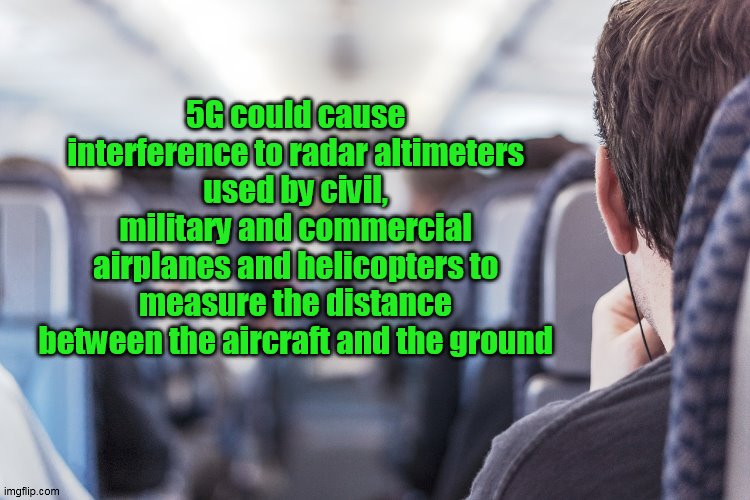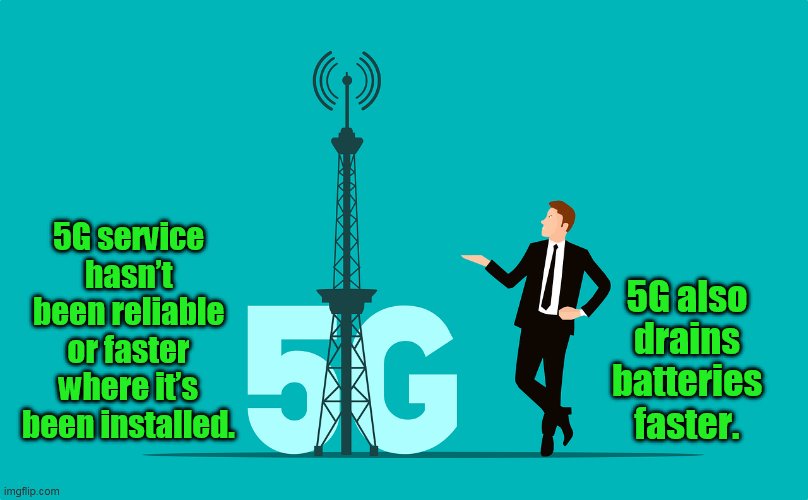 By B.N. Frank
By B.N. Frank
5G warnings and opposition has limited, slowed, and/or stopped deployment worldwide including near some U.S. airports due to dangerous interference issues with aviation equipment (see 1, 2, 3, 4). Nevertheless, activation has continued throughout the U.S. which may or may not have created some recent problems at Texas airports. Now the Federal Aviation Administration (FAA) is asking that NO ONE operate 5G in the C-band near airports.
From RCR Wireless:
FAA to FCC: Mandate 5G C-band restrictions around airports
By Peter Cohen
AT&T and Verizon are already on board, but the FAA is worried about smaller operators and spectrum holders
When it comes to rolling out 5G C-band services, the U.S. Federal Aviation Administration (FAA) wants the Federal Communications Commission (FCC) to mandate that smaller Communication Service Providers (CSPs) abide by the same restrictions that Verizon and AT&T agreed to voluntarily, earlier this year. Reuters claims the request was made in a letter between the two agencies dated Friday, October 21.
In January, the FAA issued 5G-related aviation warnings to pilots suggesting that some on-board aviation systems can be disrupted by C-band operations. The Notices to Airmen (NOTAMs) warned pilots that altimeters, automated landing and heads-up displays/enhanced flight vision systems for aircraft should be considered unreliable for use in specific geographic areas, as should the use of helicopter autopilot hover modes.
The FAA expressed concerned about the possibility of out-of-band interference with altimeter systems, which were not designed to deal with a changing RF environment or terrestrial 5G operations but are crucial to the ability to gauge how far an aircraft is above the ground at low altitudes, particularly during times of low visibility. Within days, the agency cleared about 45% of the U.S. commercial fleet for low-visibility landings at some airports.
In June, Verizon, AT&T and federal regulators said they’d come up with an agreement. In a statement, Verizon EVP Craig Silliman called the move “a path forward that will enable Verizon to make full use of our C-band spectrum for 5G around airports on an accelerated and defined schedule.”
The phased approach “requires operators of regional aircraft with radio altimeters most susceptible to interference to retrofit them with radio frequency filters by the end of 2022. This work has already begun and will continue on an expedited basis,” the agency said. Meanwhile, it says it has worked with AT&T and Verizon to identify airports where they can use their C-band spectrum with “the least risk of disrupting flight schedules.” The companies agreed to delay 5G C-band deployments near airports until July 2023, at which time air carriers are required to have completed avionics retrofits to mitigate possible 5G C-band spectrum interference.
In the letter referenced by Reuters, acting FAA administrator Billy Nolen warned that “aviation safety would be compromised if the U.S. government does not codify certain additional operating limits in the 5G C-band environment.” The letter was distributed to the National Telecommunications and Information Administration (NTIA) and to FCC chair Jessica Rosenworcel (the FCC oversees NTIA operations). None of the parties commented to Reuters about the contents of the letter.
The FAA letter states that the 5G mitigation zones around airports have been agreed to entirely voluntarily by AT&T and Verizon. Nolen noted that his agency has no regulatory authority to require the 19 other spectrum holders to adopt the same restrictions agreed to by AT&T and Verizon. He wants FCC and NTIA to codify the process.
Of course, 5G interference issues are not isolated to aviation equipment. In 2020, utility companies and associations filed lawsuits against the FCC for not protecting utility infrastructure from potential electrical interference issues with 5G (see 1, 2). Telecom provider, SpaceX has stated that Dish’s 5G satellites will cause interference issues affecting Starlink satellite service. DirecTV and RS Submit have also warned about satellite interference issues. The Department of Defense (DoD) has also been trying to resolve potential 5G network interference issues with military radar. In August, a bi-partisan group of senators requested that the FCC reconsider harmful interference risks with associated Ligado’s network before allowing it to be activated. Fortunately last month, Ligado cancelled trial network plans, perhaps because of a report that also warned about interference. Earlier this month another report revealed that the telecom industry was aware of “known RF challenges” with 5G as well!
Additionally, doctors and scientists have been asking for 5G moratoriums on Earth and in space since 2017 due to biological and environmental health risks (see 1, 2, 3, 4). Since 2018 there have been reports of people and animals experiencing symptoms and illnesses after it was activated (see 1, 2. 3, 4, 5). In 2019, telecom executives gave congressional testimony that they had NO scientific evidence that 5G is safe. In fact, the majority of scientists worldwide oppose deployment. Some researchers have also warned that activation may be contributing to COVID-19 infections as well as hundreds of thousands if not millions of bird deaths. Of course, research has also determined that with exposure to 4G and other sources of wireless Wi-Fi radiation and Electromagnetic Fields (aka “Electrosmog”) is harmful too. Nevertheless, the FCC (see 1, 2, 3, 4, 5, 6, 7, 8) – the regulatory agency which lost a lawsuit for NOT updating wireless radiation guidelines (including 5G) since 1996 – and other American government and state agencies and committees (see 1, 2, 3, 4, 5, 6, 7) have continued to promote and fund 5G deployment and densification (see 1, 2) as well as that of 4G and public Wi-Fi (which also poses known health and environmental risks). American businesses – including restaurant chain Panda Express – are expanding 5G deployment and activation too!
Other widely reported issues associated with 5G include poor service (see 1, 2, 3, 4, 5, 6, 7, 8, 9) and cybersecurity risks (see 1, 2). Of course, 5G doesn’t seem to be the end goal – it’s 6G – which is controversial, too.
Activist Post reports regularly about 5G and other unsafe technologies. For more information, visit our archives and the following websites:
- Americans for Responsible Technology
- Wireless Information Network
- Environmental Health Trust
- Physicians for Safe Technology
Become a Patron!
Or support us at SubscribeStar
Donate cryptocurrency HERE
Subscribe to Activist Post for truth, peace, and freedom news. Follow us on SoMee, Telegram, HIVE, Flote, Minds, MeWe, Twitter, Gab, What Really Happened and GETTR.
Provide, Protect and Profit from what’s coming! Get a free issue of Counter Markets today.


Be the first to comment on "FAA Asks FCC to Mandate 5G C-band Restrictions for All Providers Around Airports Due to Ongoing Interference Issues"